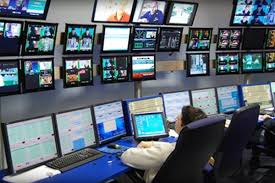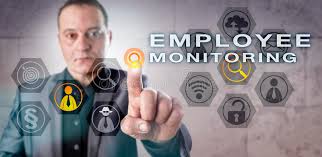Does your boss know how much time you spend having coffee breaks? In meetings? Doing work at your desk? Doing nothing? Probably not. Or if yes, in a very general way, like looking at your Outlook calendar. Until recently it has been difficult for organizations to specifically monitor the activities of employees. No longer.
We are witnessing an explosion of employee monitoring systems and technological devices to facilitate that monitoring. The culture of surveillance has now invaded the workplace.
From one perspective, the spread of employee monitoring systems parallels the expansion of surveillance programs by government and law enforcement agencies, with a focus on safety or prevention of crime. That said, one the main drivers for employee monitoring has been concerns about employee productivity, as evidenced by numerous reports indicating the decline of worker engagement and productivity levels in the workplace.
The form that employee monitoring takes is varied and sometimes multi-purposed. Here’s are some examples:
- Nurses and patient care technicians in selected units at a Florida Hospital, Celebration Health, wear badges embedded with sensor technology that tracks exactly where the employees go during their work shifts and for how long.
- JP Morgan has a surveillance program in its trading business which monitors the trading activities of employees and has plans to eventually spread it throughout all banking divisions, a system designed to control possible illegal or unethical practices by traders.
- A company called Humanyze uses a combination of microphones, infrared sensors, accelerometers and Bluetooth to measure employees’ movements, face-to-face encounters, speech patterns, vocal intonations, physical posture and details of conversations.

Even as far back as 2007, a widely cited survey by the American Management Association and the ePolicy Institute found about two-thirds of employers polled monitored their workers’ web use, and 45% said they monitored how employees were spending their time on company computers, the content they viewed, or the actual keystrokes they entered. One aspect of employee monitoring systems that is interesting is that most of them target line employees and not senior managers or high level executives in the organization.
Imagine this scenario in a typical office in the not too distant future. You are in employee at a meeting, and everyone participating places their phones on the table before conversation begins. Everyone is wearing sensor tracking badges around their necks. A fellow team member of yours is speaking about an issue and you interrupt him with a side comment. All the phones on the table start beeping. The meeting “mediator” who is not in the room, but observing the meeting via a video camera, reminds you not to interrupt others during a meeting. When the meeting is over, your boss calls you into his office. He shows you a series of technical images that represent the bodies in a conversation. “See this sequence of images of you,” he says, “the thermographs and bio-readouts show your blood pressure spiked several times during the discussion when your colleague spoke. Is there a problem between you?”
An even more extreme scenario would be monitoring systems that predicted aberrant behavior—such as bullying, stealing company information or loafing on the job—before it happened by monitoring brain waves, much in the fashion of the movie Minority Report.
Far fetched? Not from a technological point of view.
Companies such as Volmetrix, Humanyze, Social Intelligence, and Sociometric Solutions have already developed sophisticated monitoring/surveillance systems that are in use today.
What would be the motivation for employers to develop and use such monitoring systems? Here’s the advantages as argued by proponents )of monitoring:
- Employers learn conditions under which employee performance is optimized.
- Employee performance reviews can be more accurately determined as a value proposition. “The underlying principle is value for money,” says Joseph R. Garber, a columnist for Forbes magazine. “If you don’t deliver value for money, in some sense, you’re lying.”
- Theft of company information is controlled. Beyond worry about lost productivity, employers have legitimate concerns about the use of e- mail for thefts of proprietary information, which, according to the “Handbook on White Collar Crime,” account for more than $2 billion in losses a year.
- “Cyberloafing” (wasting time doing personal communications or internet browsing). A study by Nielsen Media Research found that employees at major corporations such as IBM, Apple, and AT&T logged onto the online edition of Penthouse thousands of times a month.
- Potential cases of bullying or harassment are discouraged or thwarted.
- Distractions are reduced to improve productivity.
Critics counter these advantages, suggesting employee monitoring creates privacy problems, reduces employee trust and motivation and defines work as being more mechanistic and dehumanized. Some research suggests that excessive monitoring can itself curb productivity and innovation, says Karen Levy, a fellow at New York University’s Information Law Institute and the Data & Society Research Institute.
Harvard Business School assistant professor Ethan Bernstein suggests overly aggressive monitoring and measurement leads workers to hide or simply refrain from any deviations from established practice—even those that benefit the company. Trust is often mentioned by opponents of monitoring as a major ethical issue. As Rita C. Manning writes in the Journal of Business Ethics, “When we look at the workplaces in which surveillance is common, we see communities in trouble. What is missing in these communities is trust.”

Bahaudin Mujtaba of Noval Southestern Univesity in the Journal of Applied Management and Entrepreneurship argues “While employers use monitoring devices to keep track of their employees’ actions and productivity, their employees feel that too much monitoring is an invasion of their privacy.” He concluded “”About 80% of employees in industries such as banking, insurance, telecommunications, travel, and other related service industries might be subject to some level of telephone or computer-based monitoring,” in some cases, without their knowledge.
The implications of a sociometrically quantified organization are profound, and indeed may end up redefining the nature of work and the workplace. Are we headed to a Brave New World or dystopia in the workplace?
Read my latest book: Eye of the Storm: How Mindful Leaders Can Transform Chaotic Workplaces, available in paperback and Kindle on Amazon and Barnes & Noble in the U.S., Canada, Europe and Australia and Asia.



